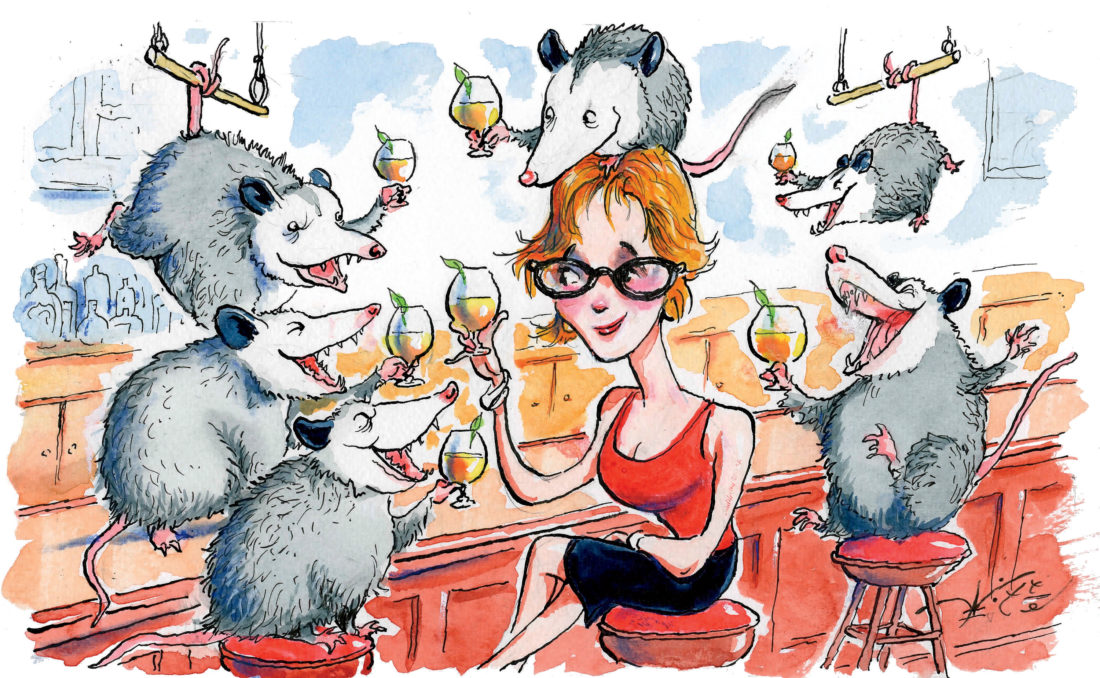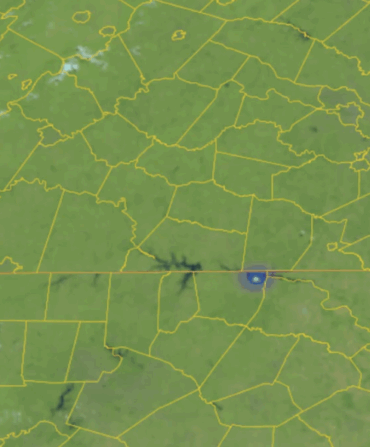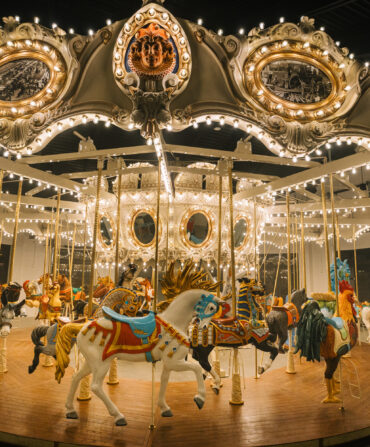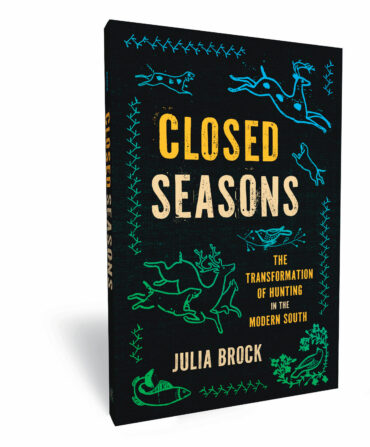Last summer I had the pleasure of signing books at Asheville, North Carolina’s terrific independent bookstore Malaprop’s, which also stocks a variety of very cool postcards. I was struck by one in particular: a delightfully naive pencil drawing of a sweet mama possum toting a passel of babies on her back (passel is the correct term for a group of possums, by the way, as in a wake of buzzards or a gaze of raccoons). The drawing
was inside an outline of the state of North Carolina, which had, according to the text, designated the Virginia opossum as its state marsupial in 2013.
Without delving too deep into potentially divisive territory here, I would venture that voting for an official marsupial might be a less, um, disruptive use of the North Carolina legislature’s time than some of the other stuff they’ve gotten up to of late. And, you know, it wasn’t that hard: Didelphis virginiana happens to be the only marsupial (pouched mammal) in all of America, and Canada too.
Though there are several species of marsupials called possums in Australia and New Guinea, scientists now believe that all marsupials (including the ancestors of the kangaroo and the koala) originated in North America and that they did so at least sixty-five million years ago. Nobody named them until 1608, when Captain John Smith came up with “opassom,” from the Algonquian term meaning “white animal.” Folks started dropping the o pretty early on, but Smith stuck with it, writing: “An Opassom hath an head like a Swine, and a taile like a Rat, and is of the bignesse of a Cat. Under her belly shee hath a bagge, wherein shee lodgeth, carrieth, and suckleth her young.”
The good captain made no note of his sentiments toward the creature, but I could tell that the artist who drew the postcard, Julie Wade, is as crazy about possums as I am. For one thing, she drew hearts in all four corners. It turns out that there’s a growing number of folks who also feel fondly toward the much-maligned mammal. Rick Ostfeld, senior scientist at the Cary Institute of Ecosystem Studies in Millbrook, New York, calls possums “the unsung heroes in the Lyme disease epidemic.” Unlike the lazier tick carriers Ostfeld studied, including rodents and birds, they are star groomers, he says, “hoovering up more than 95 percent of the ticks that try to feed on them.” A single possum can kill a whopping four thousand ticks a week, and they also get rid of a whole bunch of other stuff that most folks would rather not have around. They eat garden pests such as snails and slugs and beetles, they keep roaches and rats at bay by competing for their food or simply killing them when they trespass on their territory, and, thanks to their remarkably efficient immune systems, they can consume rattlesnakes and cottonmouths without being affected by their venom. Further, unlike the great majority of other mammals, they are happy to dine on carrion, a proclivity that has earned them the sobriquet “sanitation workers of the wild.”
They are also possessed of an impressive set of physical attributes, not least of which is a forked penis, a curiosity that led colonial Americans (who apparently conducted some mighty close anatomical inspections) to believe that the male possum bred with the female through her nostrils. They do not, in fact, hang from their prehensile tails (or at least not for long—once they’re grown they’re way too heavy); they use them instead for stability while climbing and to carry bundles of grasses for their nests. Like some primates, they have opposable “thumbs” on their hind feet, which make them uncommonly agile, and they have more teeth—fifty—than any other mammal except the killer whale and the giant armadillo. The latter gave rise to the expression “grinning like a possum eating a sweet potato”—or a persimmon, which they especially like, but you can fill in the blank with almost anything. A friend of mine swears that when he kicked a mule to see if it was really dead, two possums emerged from its rear end, an admittedly disgusting image that might well explain the origin of another adjective having to do with a grin, but hey, this is nature, after all.
A possum is a nocturnal, naturally gentle sort who tries admirably hard to keep to him- or herself, so all those teeth are rarely put to use biting humans. “Playing possum” is a real thing—an involuntary response to danger in which the creatures fall into a catatonic state for up to four hours—as well as a trait I’d most love to have. Imagine being able to go rigid and stare off into space every time someone bugged or bored you (this is sometimes preceded by belching and hissing, which would also be pretty damn effective). The late columnist Robert Novak once hit the floor of my living room after being treated to a lengthy monologue by the pedantic tax reformist Grover Norquist. An ambulance was duly summoned, but by the time it arrived, Novak was fine and I knew exactly what had happened, having talked to Norquist myself. One does what one can to survive.
The downside for possums is that these instincts are often switched on in the middle of a highway, where they spend a lot of time munching on roadkill, making the automobile the species’ most effective predator. Though said to be smarter than dogs, they are slow to get out of the way, a state of affairs that leads to the rather succinct lyrics of a ten-minute Phish song: “…riding down the road one day and someone hit a possum…The road was his end, His end was the road…Whoa possum, possum, your end is the road.”
For a long time, the possum’s end was also the serving platter. The marsupials were introduced in the western United States primarily as a food source, and as late as the 1960s, Joy of Cooking included them along with directions for proper scraping and cooking. Even now, on a website run by “Recipe Girl,” there is a plethora of possum recipes, including one for “Sweet Taters and Possum” that begins, without irony: “First catch a young fat possum. This in itself affords excellent sport on moonlit nights in the fall.” The nation’s twenty-seventh president, William Howard Taft, was so fond of possums that folks started sending them to the White House in the mail, a practice that caused a bit of a brouhaha when some Leesville, Louisiana, hunters left a live possum addressed to Taft in the post office’s package department and the traumatized animal chewed up the rest of the mail in the box.
It all started in January 1909 when the president-elect asked that possum be served at a banquet given by the Atlanta chamber of commerce in his honor. The natives of Worth County formed a Possum Committee in order to hunt and provide “one hundred fat possums,” which were then boiled, baked, and basted with a newly invented “special sauce.” Sweet potatoes were served as an accompaniment, and since “liquid from foreign vineyards” was illegal in Georgia, “a lady admirer” of Taft’s brewed a barrel of persimmon beer for the occasion. Taft was said to have gobbled up his personal possum so fast that a nearby doctor advised him to slow down. But he kept up the pace throughout his one-term presidency, driving up the cost of possum from $1 to $10 per carcass and serving up a twenty-six-pound possum at his first White House Thanksgiving. Thus began a drive to entice the president into putting other such regional delicacies on the culinary map. In Wyoming he was served prairie dog, and when it was discovered that the people of Louisiana planned to serve him alligator on a visit to the state, the New York Times was moved to publish an admonishing editorial: “It is no part of the president’s duty to eat strange foods merely to satisfy neighborhood pride. We earnestly beg Mr. Taft to stop with the ’possum.”
Waxing philosophical, a member of Taft’s Possum Committee told the Worth County Local that “a possum is not like anything else under the sun, except another possum.” While this is certainly true, there are people who bear at least a passing resemblance. His close-set eyes and distinctive nose earned George Jones the nickname the Possum long before he was saddled with the less affectionate No Show. Ezra Pound called T. S. Eliot Old Possum, and it must be said that Eliot’s nose was his most prominent feature. It’s ironic, then, that the world’s most famous possum, Walt Kelly’s Pogo, didn’t look all that much like one, though he possessed many of the creature’s more noble attributes, including a certain equanimity, humility, and the good sense to avoid trouble.
Indeed, Pogo was possum as everyman, and some of the happiest hours of my childhood were spent on my father’s lap while he read the comic strip aloud to me, hee-hee-heeing throughout. One of Daddy’s many fine qualities is his endless ability to laugh at himself, as well as at the general ridiculousness of his fellow man, a particularly useful trait if you happen to live where we live. Pogo’s full name was Ponce de Leon Montgomery County Alabama Georgia Beauregard Possum, a not-so-subtle send-up of the aristocratic airs of a certain breed of Southerner. But Pogo himself was as literally down to earth as the other members of his species.
When he and his cohorts embark on an expedition beyond the confines of home, the Okefenokee Swamp, he sends back a message: “We have met the enemy and he is us.” Yep, it surely is, but Pogo remains ever hopeful. When he tells Porky Pine that he reckons “ev’ry critter’s heart is in the right place,” Porky answers, “If you gotta be wrong ’bout somethin’, that’s ’bout the best thing to be wrong ’bout.” There is plenty more wisdom for our always unsettled times, including, also from Porky, “Don’t take life so serious, son. It ain’t nohow permanent.” It’s good stuff not just for our age (though, man, it would be fun to have Kelly around about now) but for the ages—let’s not forget that Kelly began writing the strip in 1943 and among the politicians he lampooned were Senator Joe McCarthy (Simple J. Malarkey) and Vice President Spiro Agnew (a hyena who spoke in alliterative nonsense). At any rate, it’s instructive to look back at the vast cache of strips. You never know: It could well be the unassuming possum who leads us out of our own collective swamp.
Alternatively, you could just drink yourself into oblivion with a cocktail named the Possum Drop, a creation of the legendary Snake and Jake’s Christmas Club Lounge, a pluperfect New Orleans dive lit solely by Christmas-tree lights and guarded by a dog named Odysseia. One night a possum fell through a ceiling tile and landed on a customer, and the drink, a shot of Jägermeister dropped into a pint of Schlitz, was born. Snake and Jake’s is not unlike Pogo’s Okefenokee: slightly dangerous, filled with characters, and completely cut off from the outside world. I bet even the possum wanted to stick around.
Want more Julia Reed? Her book South Toward Home is a collection of both rollicking and warm stories about the highs and lows of Southern life.








